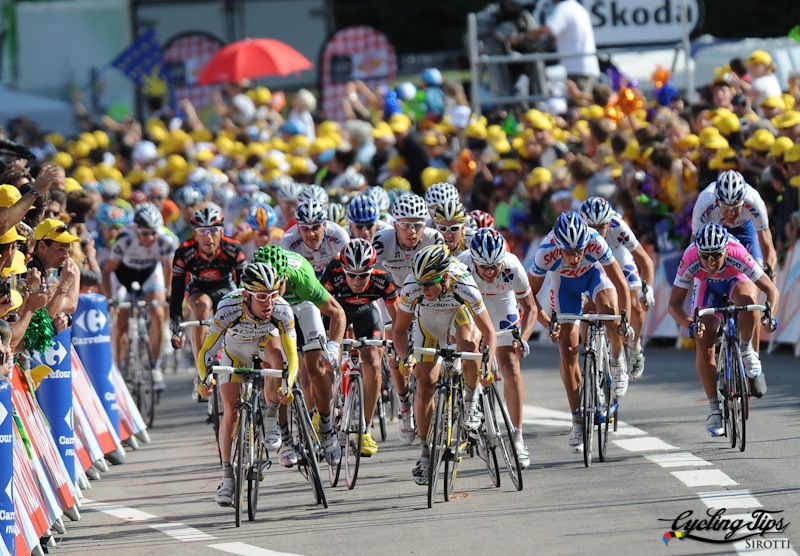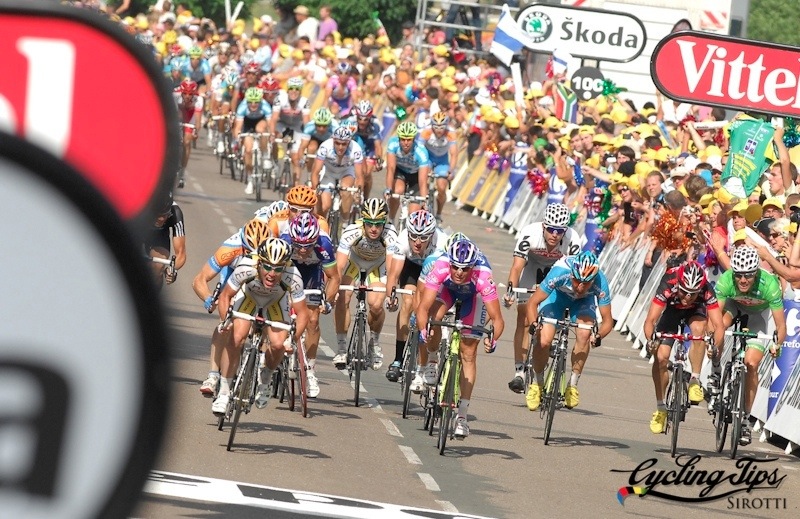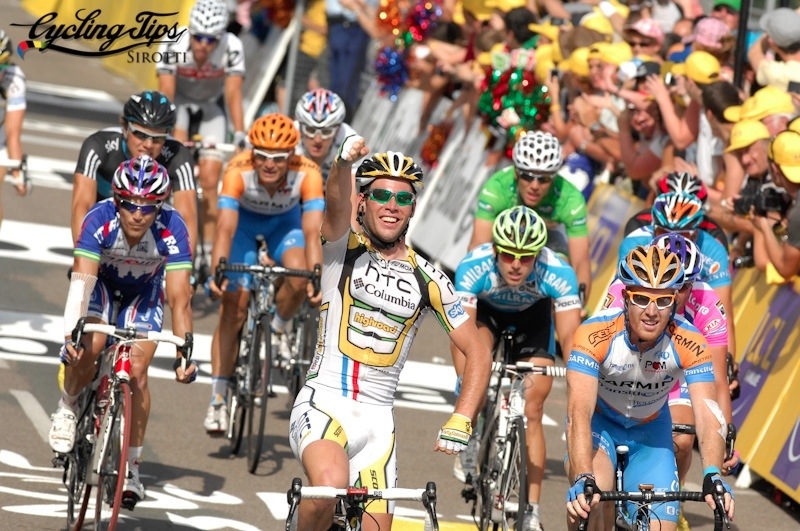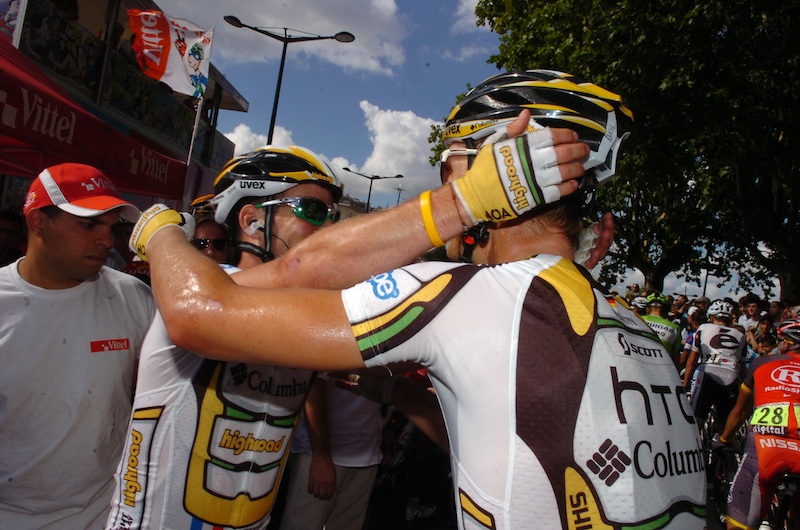Today, there’s no doubt that Mark Renshaw is the best leadout man in the business. Mark Cavendish gives no shortage of praise to Renshaw and the rest of his HTC-Columbia teammates for being instrumental to his wins. The fact that HTC-Columbia can pull these wins off again and again with such consistency is an amazing achievement.
A perfectly executed leadout train isn’t something that is typically used in amateur racing, but it’s interesting to understand the inner workings of this team tactic. I caught up with Mark Renshaw to learn exactly how HTC-Columbia’s leadout for Mark Cavendish is executed.
CT: Mark, I’ve always wondered about the intricacies of a well exceuted leadout. What is everyone’s job? What is the progression? When does everyone get organised to move to the front? Tell me everything!
Mark Renshaw : (laughs) I won’t give away too much inside info but I’ll give you a basic rundown
CT: You don’t want to give all your tricks away…
MR: (laughs) Yeah that’s right. Well everyone’s onto them now anyway. I’ll talk you through it.
First we have to decide or not whether its going to be sprint stage. We decide that in the team meeting that morning. If it is a sprint stage, we try to control it all day with one or two riders. We make sure breakaways don’t get too far ahead. We’ve been the team that basically takes on the majority of the work in the last year or two so we’ve had to commit a lot of guys early the last couple of years. So I suppose you could say the lead out actually starts as soon as you determine its going to be a sprint stage. Then if you look further ahead into the race, 20km to go is usually a good marker for when we want the whole team at the front. Last 20km seems to go pretty fast so we try to get all the guys in a line, all stay together, and you obviously all want to stay to one side. It depends what direction the wind is coming from. We use two or three guys rotating on the front, trying to keep the speed very high at the 20km mark. They’ll ride down to 10km to go and then we’ll try to bring in a couple more guys like Tony Martin and Bert Grabsch. Then 10km out it’s Cav (Mark Cavendish), myself and whoever’s in front of me. Probably Bernhard Eisel and Tony Martin again. It depends on what’s happened. But there’s at least three guys saving themselves with 10kms to go.
So basically until 10kms to go you got everyone working except for three guys. They try and keep the speed high, stay to one side, stay out of the wind, and neutralise the race if there’s any attacks. 3 kms to go is usually a pretty decisive time. That’s when all our guys are doing their last turns. So Tony Martin, you know Grabsch, guys like that are trying to do their turns through to the end as long and as hard as they can go. Tony’s always been the guy that gets us to about 1.5km-1km and then the guys have to try and get me as close to the front. I usually try to go no more than 1km out. The big goal is to bring Cav up to 200m or 250m.
Obviously you want to use all the guys possible. Everyone’s got a role. Basically thats how it works within HTC-Columbia. We’re pretty lucky, we’re all got pretty good riders. So everyone knows their role and it works out really well.
CT: Take us through your part of the leadout.
MR: This year’s Tour de France was a lot different compared to last year because we were missing some horsepower and we were riding off other teams a little bit. But if you take for example last year, 650m to go was the point where I’d start my lead-out.
You want to keep the speed as high as you can so you don’t get swarmed by other riders. I’m on the side of the road, out of the wind. That’s the other big thing.
CT: Garmin-Transitions and you guys (HTC-Columbia) are the two team rivalries in the sprints. What is it that HTC-Columbia does that makes your leadout so successful? Is it the timing? The patience and experience? How do you always manage to swarm Garmin-Transistions in the crucial final moments?
MR: Well, its experience and pretty much horsepower. I’ve got enough experience now to leave it as long as I possibly can and I’ve got the power to get out of trouble if I have to. If I’m too far back too late then I’ve got the power to move up but that’s always going to drain a bit from the finishing kick so its a comprimise. You don’t want to be too far in front or any further back than 10 guys because its just impossible to move up.
CT: Will you guys ever use a sweeper? (one teammate on Cav’s wheel to make sure that no one from another team can get on his wheel)
Mark: Nah, it never happens. Whoever it is would get smashed. I don’t think its a tactic we’ve ever used actually because we commit the whole team to Cav. Everyone wants Cav’s wheel because he’s there and gets the best leadout so it’s a tactic we’ve never use.
CT: Do other teams use it?
Mark: Oh, Garmin always try and do something stup.…something different, I suppose. More often than not, they don’t use one leader, they try and…they might have Robbie (Hunter) taking Farrar, or Farrar taking Robbie and then they try and mix it up a little bit. But that’s why it backfires maybe, they don’t commit to one guy.
CT: So what happens when it doesn’t go according to plan? When its a perfect sprint stage and you guys muck it up.
Mark: Oh yeah, we saw that this year on one of the first sprint days, not the first one, the second one at the 2km run-in we were short a couple guys at the end. Hondo attacked early and totally made me jump and then I got on the front too early and left Cav second wheel with 500m to go. And then that caught-out a lot of guys. So it does happen and you know, (laughs) everyone makes mistakes, that was my error, I just went too early.
CT: Are you pretty happy being the final lead-out man at this part of your career or is it an ambition of your to become the final sprinter? The way I see it, you have the hardest job of it all.
MR: Yeah its definitely the hardest job. Cav gets the pressure, don’t get me wrong. He gets the pressure and he’s by far the best sprinter but it helps having a good lead-out train. Hopefully down the track I’ll get an opportunity that’s for sure. For the moment I’ve committed to Cav for another couple of years. And then hopefully I’ll improve enough to take a few victories myself.
In saying that, the worlds next year in Denmark I see as a really good opportunity for myself. We travel to California on Sunday and hopefully I’ll get the chance to sit down with the team, to get a few races where I’ll be able to race for myself and have the team at my disposal and try to win some more races.
CT: Are there any times when you look back and Cav isn’t there? What happens then?
MR: I’ve never gone and Cav hasn’t been there. Ummm. I don’t think he’s ever not been on my wheel? I never even check for him. That’s up to him. If he’s there he’s there. If he’s not there that’s his fault (laughs).
I always ride in the wind for him. I always know exactly where he has to be. That’s probably why I do a good job…I’ve been a sprinter, I know where you have to be, I know what you have to do. And doing a leadout role is to put him in the right position. But he’s never lost my wheel and I think I’ve always rode pretty conservative to always make sure he’s on my wheel.
CT: Fascinating stuff Mark. Thanks so much for taking the time to give us these insights into the best leadout team in the world. See you at the Jayco Bay Crits in January.





Pingback: Race Training - Session 5 | Nick Humby()
Pingback: Explainer: how to win a Tour de France sprint | News & Events()